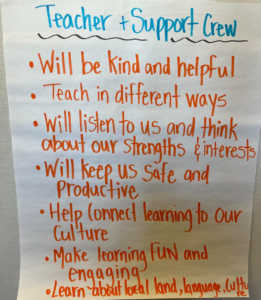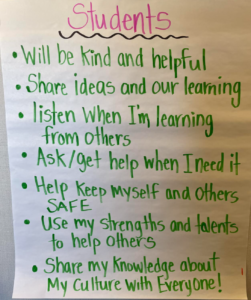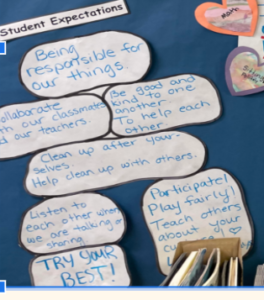Building The Community of Learners: Roles and Expectations
Guiding Understandings:
In traditional Indigenous communities, all people had specific roles and expectations to ensure that everyone survived and thrived. Our classrooms should reflect the values and beliefs about learning and work of Indigenous People, which is captured in the Dene Kede and Inuuqatigiit, and evident in all BDDEC school communities.
In the classroom, roles are grounded in values and beliefs of the community and are enhanced by the knowledge of individuals, their collective strengths, and our ability to encourage classroom community members to work collaboratively to solve problems. Roles and expectations are agreements we make around what community members will do to keep the community strong and smooth, instead of a list of rules that denote what we cannot do. Structure, consistency and predictability in how we approach, engage, communicate and problem solve provides safety for students to learn.
Big Ideas: 1. Clear knowledge of the roles and expectations of all members of the community is critically important. 2. Values, beliefs, individual and collective strengths, all contribute to informing roles and expectations in supportive classroom communities.
Essential Question:
- Why is it important to know our roles and expectations in order for our community to thrive?
- How do we use our strengths and gifts to help our community when we are struggling?
Culminating Task:
- The classroom community will produce an anchor chart or visual display about the roles of its members that will be visible for all in the classroom.
- The class will generate a list of “Fix it” strategies that help them remember their roles and the expectations that have been set. These strategies should be visible and usable by ALL students.
Connections to Core Competencies:
- Nurture who I am and who I want to be: Students learn to adapt to people and places and share gifts, act on rights and fulfill responsibilities.
- Construct ways of being and living well together: Students learn to encourage and support people to belong, assume leadership when needed and trust others in their roles, as well as reconcile histories of the ways in which schools were organized and how that needs to be different today.
- Negotiating change and challenge: Students find their way with the roles they have to play.
Connections to Capable Person:
This aspect of community building helps connect student understanding of their place in a group with ideas about learning and expectations for children and adults in a variety of situations.
Oracy Strategy:
Using the thinking routine “Give One, Get One” students will develop the skills to gather ideas and thoughts and select one to share while receiving an idea from others in return.
Inquiry Type:
Structured Inquiry: Students will receive explicit step-by-step guidelines at each stage, leading to a predetermined outcome, similar to following a recipe.
Gauging Prior Knowledge and Honoring Student Voice:
The following activities are suggestions only, which may assist you in completing the culminating task. However, Oracy development is a must, so teaching the strategy outlined is necessary in some way. As a Classroom Teacher, you may choose which activities to complete, which to remove, and where more activities need to be completed. The culminating task is mandatory to complete.
Possible Pathways:
- Teacher facilitated discussion about the various roles students have: (at home, in public etc). Teachers should use the DK and IQ information on traditional roles within communities as references (see resource sheet) to inform their own knowledge and understanding of the cultural significance of roles and expectations for community members.
- Activity that helps students and school staff think about their roles in the classroom community
- Rotating stations for small groups to add to roles and expectations
- Art activity for students to reflect on and share their understanding of Roles in the classroom community
Learning Connections:
- Dene Kede (pages. xxxi, xxxvii, xxxviii)
- Inuuqatigiit (pages. 8-16)
- ELA Outcome 3 & 5
Look Fors:
- All members of the community understand their roles
- All members can explain the connection between roles and their community’s ability to thrive and function.
- All members of the community are able to change or adapt their behavior according to their roles and responsibilities.
- All members have strategies to get back on track
Teacher Reflection:
- What are all of the Roles you play as a classroom teacher? Which do you feel is the most important?
- What are your thoughts about the information in the DK/IQ Resource page in this component?
- In what ways were expectations of your students for their role as learners different from your own?
- Ask your SA(s), or Indigenous Languages Instructor(s) about what they believe the roles and expectations are for teachers and for students.
- How are expectations different from classroom rules?
- How do the roles differ for students with different strengths and stretches?
Activities
Activity 1: Learning to communicate in the community
Students will begin to work on the competency of communication through developing oracy skills. They will use the thinking routine Give one, Get One as a structure to get students talking.
Give One, Get One
How To:
- Students will have a few minutes to think independently and record their thoughts on a sheet that is separated into two columns: one column marked “Give one” & one column marked “Get one”
- Students add their own thoughts to the “Give One” category (for younger students this could be recorded as pictures or key words)
- Students are then asked to find a partner
- Students share ideas with one another about the topic out loud from their “GIVE ONE” area of their paper
- Students are looking to add an idea that they did not have to their list in the “GET ONE” area of their paper
- Students should be able to partner with AT least 2-3 pairs in order to share and receive ideas.
Topic: What do we want our class to do this year?
Activity 2: Use the resource sheet to lead a discussion/ activity about traditional roles of children and adults in Indigenous communities.
Roles and Expectations:
Understanding individual roles and expectations is an essential factor in a community thriving and surviving. In traditional Indigenous communities all people had specific roles and expectations to ensure that everyone survives and thrives. These roles are grounded in values and beliefs of the community and are enhanced by the knowledge of strengths and our ability to encourage community members to work collaboratively to solve problems.
Roles refer to the position or purpose that someone has in a community/relationship and expectations refer to the individual jobs/duties that each member is responsible for.
In a classroom, defining the roles and expectations of each member can help to create an environment where individuals have a clear understanding of the expectations of each member. This clarity allows members to utilize their strengths to help the community flourish and additionally, step-up when members of the community are languishing.
Roles and expectations need to align with the classroom values and beliefs.
Classroom | Role | Expectations |
Individual |
|
|
Collective |
|
|
Dene Kede and Inuuqatigiit:
The following are examples of traditional roles and expectations from the Dene Kede and Inuuqatigiit. Traditional roles and expectations have changed over time and need to be approached with sensitivity and awareness of change. These are NOT meant to be used as examples when developing current community roles and expectations. They are provided to give educators knowledge to strengthen their understanding of traditional Indigenous communities and their connection to people and place.
Cultural Connection Examples | Roles | Expectations |
Dene Kede | The Child | “It is hoped that through the development of this curriculum the children will realize how valuable they are to the Dene culture, Elders, and people. Students should learn how children were viewed and brought up traditionally. They should evaluate child-rearing methods in the past and compare them with present methods. They will understand the importance of sharing, being self-disciplined, and learning from their Elders.” (Pg.152) |
Men and Women | “Students should understand that men and women rely on each other and share work equally. Students will recognize that Dene can still follow traditional ways and that is essential to survive in today’s world. Students should understand and respect the modern and traditional roles of men and women, and realize that they themselves will need these skills in order to teach future generations.” (Pg.166) | |
Friends | “Students must learn to respect the value of friendship, and the Dene perspective of friendship. Friends can mean many different things: nature is a friend (wood, food, weather, ants, etc…). To succeed in life and to maintain a livelihood, it is important to have friends and to be a friend.” (Pg. 171) | |
Inuuqatigiit | Girls | “Girls were raised to be mothers and providers for their family. With gentle encouragement from their mothers and grandmothers, girls learned how to sew, prepare skins, cook and preserve food. They were taught to be observant of anything that would enable them to better their skills. Elders would like girls to learn how to sew clothing since this is still important today. As the lifestyle of Inuit has changed so too has the role of girls and women. More and more females are taking roles that males would only hold in the past. The female/male topics should be treated with sensitivity and taught at the same time; as the roles of family are changing rapidly.” (Pg.59) |
Boys | “From the time boys were born, the family had expectations of them becoming good hunters and providers. The boys were taught to be observant, react quickly and try their very best. Boys were raised to think of themselves as future providers and protectors and to excel at whatever they try to do. Many of the responsibilities of boys have changed over the years. The Elders would still like the boys to learn hunting and survival skills, and enjoy being out on the land.” (Pg. 63 ) |
Activity 3: Practice A/B Partner Talk!
Topic:
What are roles and expectations for children and youth at home or in public? How do you know what your role is (who tells you?) Why do we have roles?
Think:
As a teacher, you can vary the complexity, breadth, and expectation of student shares. You can present the big idea for some and add the extra questions for other groups who appear ready.
Remember:
- A/B partner talk needs a script or sentence stems that students can use to help capture their ideas for sharing out.
- The teacher or the students can decide who is partner A and who is partner B in each group.
- Partners alternate sharing EACH OTHER’S ideas depending on which partner is called first (ex: partner A shares out partner B’s ideas)
- The script and sentence stems should relate to the given concept or topic AND build in complexity as students get confident using the structure.
- If the script is more complex students may need to take a couple notes to capture their partners ideas and responses.
Sample script (s):
Basic:
- My partner thinks that __________________________________________________ are roles for young people at home and ___________________________________________ when they are in public like the store and the youth center.
More Complex:
- My partner thinks that __________________________________________________ are roles for young people at home and ___________________________________________ when they are in public like the store and the youth center.
- ___________________________________________ is someone who helps me understand my role at home, the kinds of things I do at home to help are _________________________________________________ and ___________________________________________________________________________________________.
- I think we have roles and responsibilities so that ______________________________________________________________________________________________________________________________________________________________________________________
Activity 4
Task: Students and classroom adults are going to participate in a few rounds of the Give One, Get One to generate ideas about roles and expectations in the classroom community
- This will help get ALL voices to feel represented and serve to co-create expectations in the classroom community
- Where possible, include all adults that will be a part of the classroom community (SAs, PSTs, Instructional Coaches, etc)
- Students can express ideas in writing or in drawings
- Encourage students to think about the strengths that you have put around their belief statement when they are thinking about their roles and expectations in the classroom community.
*** Everyone will need a divided sheet for each of these rounds ***
First Round Topic:
What are the roles of students in a classroom community?
Second Round Topic:
What are the roles of the teacher in the classroom community?
Third Round Topic:
What are the roles of all of the adults (SAs, PST, Instructional Coaches etc) in the classroom community?
Possibilities for sharing ideas:
- Once students have shared with each other, students can put one of their Give Ones on chart papers for each of the rounds
- Students and adults can share ideas to the whole group and the teacher can record them in each of the areas
- Students can work on recording ideas on a chart paper for the first round
- The teacher can record ideas on the chart paper for the second round
- Other adult members can work together on the chart paper for the third round
- Each group can share their work to the other groups
Sample of creating the classroom community roles and expectations.
Activity 5: Essential Question: How does our own behavior influence the success of the whole community?
Task: Introduce scenarios that will require the classroom community to work together to create lists of “fix it” strategies to help get back on track.
*** For each scenario, the teacher will read the problem and brainstorm strategies with the class to help “fix it.” Students will then use the strategies to role play “fixing” the issue.***
Example Scenario:
A task that requires students to get into groups is assigned. The groups are student choice, but there are a few students that don’t have a group or don’t want to join a group which is holding the class up from getting started.
Step 1: Generate a list together of some strategies to try in order to “fix” this problem:
- Worry less about how many can be in each group
- Encourage students who are strong in group work to invite the students in
- Make sure that students know they can help their group with ideas but don’t necessarily need to be the recorder of the sharer– there is space in a group for those that just share ideas
Step 2: Role Play: Have students pretend to be in a group already and invite hesitant members in:
Sentence stem ideas for the role play:
Group member:
“Hey ________________________ you can join our group? We have a recorder already but we really could use your ideas.”
Student that is hesitant to join the group:
I don’t really like group work.
Group member:
“In this group, we believe ______________________________________________ and your ideas will help us
_____________________________________________.
You don’t have to share with the whole class. We will help you feel confident by ________________________________________________
***What else would a hesitant member like to hear in order to join a group? ***
Task:
- Brainstorm some other scenarios and make them visible to the students on the board, chart paper etc.
- Have students select scenarios to share with the class. For each scenario, generate a list of ‘fix it” strategies and get students to think about how they could help get things back on track.
Then have students role play using these strategies.
Scenarios that need fixings:
- __________________________________________
- __________________________________________
- __________________________________________
Task 3: Generating strategies for the classroom community to use:
- Have students brainstorm a list of phrases they can use to help members of the classroom community get back on track when they are struggling. (record these on chart paper for them to see)
- Have students brainstorm a list of things they think students need to help them get back on track or fix their behavior.
***Goal for this part is that teachers make a desk card for the fix it sentence stems for each student that can be used independently***
Look Fors:
- All members of the community are able to change or adapt their behavior according to their roles and responsibilities.
- All members have strategies to get back on track
Activity 6: Land and Community Connections
Activity Ides:
- Go on a walk with your students outside.
- Think of a way that you and your students can show land stewardship as a class.
- In this region, taking care of the land is a value and collective expectation. How can you and your class help care for and respect the land with which you live?
- Some Ideas to get you started:
- Invite an Elder or knowledge keeper who is physically able to join you along your walk and invite them to share their ideas about taking care of the land along the way.
- Choose an area around the school or along your walk route to keep clean
- Hold a discussion along your route about how we are connected to the land and what the expectations of that relationship are
- Stop along your route and have students discuss and share ways that they can play an active role in helping support and care for the land in their community
- One of the goals in this land connection section is to think about roles and expectations in different scenarios and to recognize that collectively honoring our roles helps our relationships and communities thrive.






